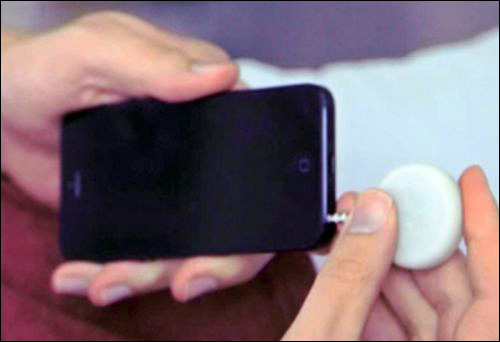When Apple released its new iPhone 5 in September 2012, many in the Near Field Communication (NFC) industry were disappointed to learn that it lacked an NFC reader. Therefore, one group of developers aimed to do something about Apple’s omission. Startup NFC application developer Flomio has created the FloJack, a pocketsize, one-ounce dongle that serves as an NFC reader able to be plugged into newer Apple mobile phones and iPod Touches, as well as iPad and Android devices. The solution was introduced last month on Web-based funding platform Kickstarter, where the company is seeking $80,000 from investors to fund the products’ commercial release. The firm has earned approximately $16,500 to date, with 18 days of the fundraiser remaining. The money will help pay to manufacture the FloJack, and aid in the development of additional functions and improvements.
The FloJack plugs into an Apple device’s headphone jack, automatically pairing a user’s device with Flomio’s NFC Quick Actions suite of apps to enable NFC reads. Flomio chose to build the FloJack to plug into a device’s 3.5-millimeter (0.1-inch) audio jack, according to Tim Ronan, one of the company’s cofounders, since it is a universal connector. “Every phone, PC and touchpad has one,” he says, “which means the FloJack can easily NFC-enable any iPhone, iPad, legacy Android phone or any other smartphone out there. It was meant to act as an invitation for everyone to join the NFC party.”
Flomio, based in Miami, Fla., was launched in 2011 as a solutions provider for NFC-based mobile applications, says John Bullard, a company cofounder and a former enterprise software developer. About a year after that launch, he reports, the company’s technology developers were eagerly anticipating the release of the iPhone 5 with NFC technology, but the new phone model ultimately arrived without that capability. “That was crushing,” he states. “But we realized we have a team to build an NFC reader ourselves.”
Flomio views the FloJack as a bridge to enable NFC use by Apple product users, Ronan says, only until Apple begins building NFC readers into new versions of phones and tablets. “It’s like an NFC Band-Aid,” he adds. However, it will also operate with Android phones that do not already have built-in NFC RFID readers, once Flomio creates the necessary Android libraries (codes for the Android operating system), which Flomio intends to do in the near future. With the availability of NFC payment tools, such as Google Wallet (see RFID News Roundup: Google Unveils NFC-Based Mobile-Payments Service), the company expects that the need for NFC technology will increase for those with Apple and Android products. Google Wallet lets users access credit-card accounts, and make payments with those accounts at stores, using the phone’s NFC reader.
According to Bullard, Flomio considers itself an app developer first, rather than a hardware provider. Initially, its apps—all NFC-based—are free. Its NFC Quick Actions suite of apps is already available for Android phone users, and can be downloaded for free from the Google Play Web site. In the future, the firm plans to launch new apps—such as NFC Events, to manage conferences or other events with NFC wristbands—that will not be free. The company is currently offering its free “Zapps,” which are functions of the NFC Quick Action App. Those functions include App Triggers, NFC Greeting Cards, Safety First Zapps and Zapp Onto Wi-Fi. The App Triggers Zapp enables a user to, for example, direct an NFC-enabled phone or device to a URL that provides directions to a particular location (such as the user’s party from a tag attached to an invitation). The Safety First Zapp allows a user to put a phone in silent mode—for instance, when it is tapped against a tag on a car’s dashboard. With Zapp Onto Wi-Fi, a user could read a tag at a Wi-Fi location, such as a coffee shop, to place the phone into Wi-Fi mode. In each case, a shortened URL is written to the tag—such as those employing bitly‘s URL-shortening service—which links to a longer URL for a site on which the data targeted for the phone user is located. Flomio’s NFC Quick Actions suite of apps will eventually be available as a version for Apple devices phones.
For those looking to develop applications for the FloJack, the company also offers an Open FloJack software developer’s kit (SDK), to allow them to add NFC functionality to their iOS (iPhone-based mobile operating system) apps.
The FloJack’s development began with a prototype that the company likens to a lunch box that also “weighed a ton.” It has since been reduced to the pocketsize dongle currently being beta-tested by 130 individuals via Kickstarter.
The FloJack is compatible with the iPhone 4, 4S and 5 models, as well as the iPad, iPad2 and iPad3, along with the fourth and fifth generations of the iPod Touch. It is powered with the type of standard 3-volt lithium battery that can be purchased in stores. Because the dongle goes into sleep mode when not in use, the company estimates battery life at one year. If funding allows, the firm plans to begin a regulatory certification process for the device, and to start sourcing components manufacturers. By March 2013, the company expects mass production to be underway.
According to the company, the FloJack is anticipated to cost $49, while the app to operate it would be free.
During the past week, Bullard has also developed a mobile voting app known as Hack the Vote, to address voting delays in the existing voting process. In this case, an NFC tag could be attached to a registration card, and a user could tap the card before voting, then access the ballot, make selections on the phone, tap the registration card again to link their registration number with the vote, and send that vote from the phone to the election entity’s server. That development is currently only a demonstration of the kinds of innovation that can be done, however, Ronan explains, and is not being adopted by any election agencies.
If Flomio fails to gain $80,000 from the Kickstarter funding application, Ronan says, “We’re going to keep moving forward.” Details regarding those alternative funding sources, however, have yet to be determined.



